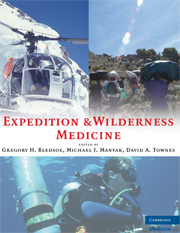Preface
Published online by Cambridge University Press: 05 March 2013
Summary
As long as there have been expeditions, there has been expedition medicine. Whether it was Dr. David Livingstone treating his exploration party with quinine as they traveled up the Zambezi, Meriwether Lewis receiving medical training from Dr. Benjamin Rush, James McIlroy amputating frostbitten toes during Ernest Shackleton's Imperial Trans-Antarctic Expedition, or Dr. Jose Antonio Cajazeira treating Theodore Roosevelt on their Brazilian River of Doubt journey, expeditions and medicine have demonstrated a natural tendency to intersect.
In spite of this long and colorful history of medicine on expeditions, defining “expedition medicine” is no easy task. A medical professional providing medical care on an expedition might need to be a high-altitude expert one day and a tropical medicine expert the next. Exposure to envenomations, animal attacks, parasitic disease, and environmental extremes all may occur while traveling through remote areas on expeditions. It is this diversity of practice, and this intersection of medicine and nature, that initially draws many individuals to expedition medicine, and yet, when attempting to assimilate these varied topics into a single functional text, it is just this diversity that creates difficulty.
The editorial team has selected topics for this text that represent both the depth and the breadth of this expansive medical discipline. We recognize that even as individuals are drawn to different geographic environments, readers will use this text for different purposes.
- Type
- Chapter
- Information
- Expedition and Wilderness Medicine , pp. xix - xxPublisher: Cambridge University PressPrint publication year: 2008



